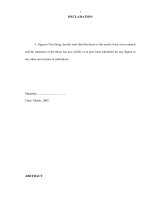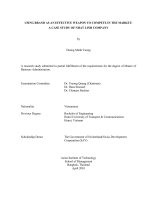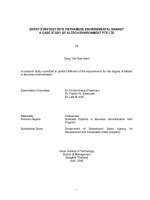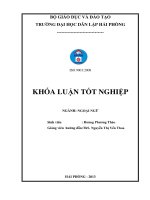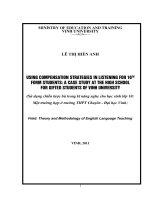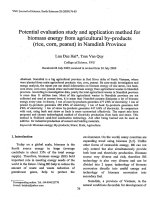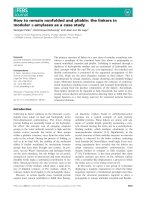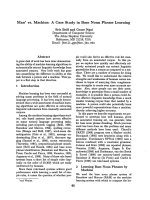Practical constraints in EFL Vietnamese classrooms affecting speaking assessment a case study in Nam Dinh Upper-Secondary schools
Bạn đang xem bản rút gọn của tài liệu. Xem và tải ngay bản đầy đủ của tài liệu tại đây (309.6 KB, 6 trang )
VIETNAM NATIONAL UNIVERSITY- HANOI
UNIVERSITY OF LANGUAGES AND INTERNATIONAL STUDIES
FULCUTY OF POST-GRADUATE STUDIES
TRẦN QUỐC BÌNH
PRACTICAL CONSTRAINTS IN EFL VIETNAMESE CLASSROOMS
AFFECTING SPEAKING ASSESSMENT:
A CASE STUDY IN NAM DINH UPPER-SECONDARY SCHOOLS
Những hạn chế của lớp học Việt Nam ảnh hưởng đến việc đánh giá
kĩ năng nói môn Tiếng Anh: Một nghiên cứu tình huống
ở các trường trung học phổ thông tỉnh Nam Định
THE M.A THESIS
Field: Teaching Methodology
Code: 60.14.10
Hanoi - 2010
VIETNAM NATIONAL UNIVERSITY- HANOI
UNIVERSITY OF LANGUAGES AND INTERNATIONAL STUDIES
FULCUTY OF POST-GRADUATE STUDIES
TRẦN QUỐC BÌNH
PRACTICAL CONSTRAINTS IN EFL VIETNAMESE CLASSROOMS
AFFECTING SPEAKING ASSESSMENT:
A CASE STUDY IN NAM DINH UPPER-SECONDARY SCHOOLS
Những hạn chế của lớp học Việt Nam ảnh hưởng đến việc đánh giá
kĩ năng nói môn Tiếng Anh: Một nghiên cứu tình huống
ở các trường trung học phổ thông tỉnh Nam Định
THE M.A THESIS
Field: Teaching Methodology
Code: 60.14.10
Instructor: To Thi Thu Huong, Dr.
Hanoi - 2010
6
TABLE OF CONTENTS
AUTHORSHIP DECLARATION i
ACKNOWLEDGEMENT ii
ABSTRACT iii
LIST OF TABLES iv
LIST OF ABBREVIATIONS v
TABLE OF CONTENTS vi
PART I
CHAPTER I: INTRODUCTION
1.1 Rationale of the research 1
1.2 Research questions and research aims 2
1.3 Scope of the study Error! Bookmark not defined.
1.4 Methodology 4
1.5 Significance of the study 5
1.6 Design of the study 5
PART II
CHAPTER II: LIERATURE REVIEW
2.1 Constraints in oral teaching skill at Vietnamese lower secondary school and
tertiary education 7
2.2 Constraints in speaking teaching in Vietnamese upper-secondary schools 9
2.2.1 Educational system 9
2.1.1.1 Large classes 9
2.1.1.2 Lack of appropriate resources 11
2.1.1.3 Textbook 12
2.1.2 Teachers’ problems 13
7
2.1.2.1 Traditional way’s affection 13
2.1.2.2 Lack of English competence 14
2.1.3 Students’ problems 15
2.1.3.1 Low English competence 15
2.1.3.2 Demotivation of speaking 17
2.3 Requirements of speaking assessment at Vietnamese upper-secondary school 18
2.3.1 An overview of speaking assessment criteria at upper-secondary school . 18
2.3.2 Continuous speaking assessment 19
2.3.3 Types of speaking assessment 21
2.3.4 Criteria in speaking test 22
2.3.4.1 Validity 22
2.3.4.2 Reliability 23
2.3.4.3 Authenticity 24
2.3.4.4 Marking 25
2.3.4.5 Backwash effect 26
2.3 Role of teachers in assessing oral skill 26
CHAPTER III: METHODOLOGY
3.1. Case study 29
3.2 Steps in the selection of participants 32
3.2.1 Questionnaire Participants 32
3.2.2 Interview informants 34
3.3. Data collection 35
3.4. Data analysis 36
CHAPTER IV: FINDINGS
4.1. Overall findings 37
4.2. The practical constraints affecting teachers to conduct speaking assessment. 38
4.2.1. Difficulties caused by the educational system 39
4.2.1.1 Large classes 39
4.2.1.2 Excessive work in addition to classroom teaching 41
4.2.1.3 Textbooks 42
8
4.2.1.4 Exams’ negative backwash 43
4.2.1.5 Few opportunities for retraining 44
4.2.2. Difficulties caused by the students 45
4.2.2.1 Students’ low English proficiency 45
4.2.2.2 Students’ low demotivation 45
4.2.3. Difficulties caused by teachers 46
CHAPTER IV: FINDINGS 46
4.1. Overall findings 46
Table 3 - Practical constraints affecting teachers‟ English speaking
assessment 49
4.2.1. Difficulties caused by the educational system 49
4.2.1.1 Large classes 49
4.2.1.2 Excessive work in addition to classroom teaching 51
“The last tasks in speaking lessons in the textbook are difficult for students‟
speaking ability. I seldom quit speaking lessons but I can only use the first
two or three speaking tasks. I ask them to read aloud and learn by heart and
speak in front of the class. However, I cannot use the tasks of discussion. They
are too difficult for my students” (Teacher 1). 52
Being asked about the lack of speaking tests in the textbook, the teachers
shared their opinions: 53
4.2.1.4 Exams‟ negative backwash 53
4.2.1.5 Few opportunities for retraining 54
4.2.2. Difficulties caused by the students 55
4.2.2.1 Students‟ low English proficiency 55
4.2.2.2 Students‟ low motivation 55
All the teachers in the sample reported that students were demotivated to
learn speaking English: 56
4.2.3. Difficulties caused by teachers 56
4.2.3.1 Teachers‟ low English proficiency 56
The younger participants also shared some ideas about the problem: 57
4.2.3.2 Difficulty in eliciting students‟ responses 58
4.2.3.3 Difficulties in ensuring reliability of assessment 58
4.3 The extent that these constraints influence the ways teachers perform
assessment of English speaking with particular reference to the use of
assessment tasks 59
4.3.1. Topic 60
All the teachers who used this type of assessment doubted about its
authenticity: 61
4.3.1. Interview 62
9
Teacher 10 who used this task-type gave positive opinion about students‟
attitude: 62
However, the task make teachers difficult to lower the noise in the classroom
and to give students marks. 62
4.3.2. Personal information 62
Teachers also conducted this type for all the levels at the beginning of the
school: 63
4.3.4. Role-play 63
On the other hand, teacher 1 expressed a different opinion: 64
4.3.5. Dialogue practice 64
“If this assessment task is applied in all the lessons, it is really boring”
(Teacher 5). 65
4.3.6. Picture description 65
4.3.7 Information gap activity 66
Only one of the participants used this type of speaking assessment. 66
The teacher who was the only one using this task shared his opinions. 66
Teacher 3 thought that this task was new to him. 67
4.3.8. Discussion 67
The only teacher using this task expressed her problem of scoring. 67
This participant only applied this task in high-quality classes. 67
5.1. Nam Dinh upper-secondary English teachers‟ speaking assessment 71
5.1.1. The ways of speaking assessment in Nam Dinh upper-secondary school
English teachers 71
5.1.2. The types of non-authentic speaking assessment tasks 71
5.1.3.1 Constraints caused by students 73
Lack of English input 73
Students‟ demotivation 74
Teachers‟ lack of teaching methodology in speaking test 74
Teachers‟ low consciousness of „backwash effect‟ 75
No inter-rater test reliability 75
Teachers‟ low proficiency 76
5.1.3.3 Constraints caused by the education system 76
Large classes 76
Excessive work in addition to classroom teaching 76
Textbook 77
Exams‟ negative backwash 77
Ineffective training classes 78
Teachers‟ personal beliefs 78
REFERENCES 86
Heaton, J. B. (1990). Classroom Testing. Pearson Longman 87
Pennington, C. M. (1999). Language Learning. Arnold 89
